Dynamic Simulation of Enterprise-Level Strategic Choices in Intelligent Construction: Integration of Evolutionary Game Theory and System Dynamics
Abstract
1. Introduction
2. Literature Review
2.1. Research on the Development of Intelligent Construction
2.2. Research on Evolutionary Game Theory and Its Application in Intelligent Construction
3. Methodology
3.1. Model Assumptions and Construction
3.1.1. Problem Description
3.1.2. Assumptions and Parameters
3.1.3. Payoff Matrix and Replication Dynamic Equation
3.2. Stability Analysis of the Evolutionary Game
3.3. Analysis of Influencing Factors
4. Numerical Simulation Analysis
4.1. Construction of the System Dynamics Model and Parameter Settings
4.2. Analysis of the Impact of Transformation Elements on System Evolution in Construction Enterprises
4.2.1. Impact of Initial Conditions on the Strategic Evolution of Construction Enterprises
4.2.2. Impact of Direct Benefit Coefficient a on the Evolution of Strategies in Construction Enterprises
4.2.3. Impact of Cost Reduction Coefficient b on the Evolution of Strategies in Construction Enterprises
4.2.4. Impact of Positive Spillover Effect Coefficient c on the Evolution of Strategies in Construction Enterprises
4.2.5. Impact of Transition Incremental Cost C on the Evolution of Strategies in Construction Enterprises
4.2.6. Impact of Government Incentives S on the Evolution of Strategies in Construction Enterprises
4.2.7. Impact of Government Penalties L on the Evolution of Strategies in Construction Enterprises
4.3. Sensitivity Analysis
5. Discussion and Limitations
5.1. The Impact of Initial Conditions on Strategy Selection in Construction Enterprises
5.2. Analysis of Factors Influencing the Transition to Intelligent Construction in Construction Enterprises
5.3. Sensitivity Analysis of Key Influencing Factors
5.4. Limitation and Future Work
6. Conclusions
Author Contributions
Funding
Data Availability Statement
Conflicts of Interest
References
- Li, S.C. Analysis of the Realization Path for the High-Quality Development of State-Owned Enterprises in the New Era: A Study Based on the Construction Industry. Acad. Res. 2020, 3, 88–94. [Google Scholar]
- Turner, C.J.; Oyekan, O.; Stergioulas, L.; Griffin, D. Utilizing Industry 4.0 on the Construction Site: Challenges and Opportunities. IEEE Trans. Ind. Inform. 2021, 17, 746–756. [Google Scholar] [CrossRef]
- Li, X.; Sun, Z. Research on the Intelligent Construction System and Technology Development in Developed Countries. China Constr. Inform. 2025, 15, 74–78. [Google Scholar] [CrossRef]
- Chung, S.; Cho, C.-S.; Song, J.; Lee, K.; Lee, S.; Kwon, S. Smart Facility Management System Based on Open BIM and Augmented Reality Technology. Appl. Sci. 2021, 11, 10283. [Google Scholar] [CrossRef]
- Xiahou, X.; Yuan, J.; Liu, Y.; Tang, Y.; Li, Q. Exploring the driving factors of construction industrialization development in China. Int. J. Environ. Res. Public Health 2018, 15, 442. [Google Scholar] [CrossRef]
- Rossi, A.; Vila, Y.; Lusiani, F.; Barsotti, L.; Sani, L.; Ceccarelli, P.; Lanzetta, M. Embedded smart sensor device in construction site machinery. Comput. Ind. 2019, 108, 12–20. [Google Scholar] [CrossRef]
- Ding, L. Intelligent Construction Promotes Transformation in the Construction Industry; China Construction News: Beijing, China, 2019. [Google Scholar]
- Fan, Q.; Lin, P.; Wei, P.; Ning, Z.; Guo, L.I. Theory of closed-loop control in intelligent construction. J. Tsinghua Univ. Sci. Technol. 2021, 61, 11. [Google Scholar] [CrossRef]
- You, Z.; Zheng, L.; Feng, L. Basic theory and system architecture of intelligent construction systems. J. Civ. Eng. Manag. 2021, 38, 105–111, 118. [Google Scholar] [CrossRef]
- Liu, Z.S.; Sun, J.J.; Du, X.L.; Li, J.L.; Zhang, A.S. Research on the Connotation, Development Trends, and Key Applications of Intelligent Construction. Constr. Technol. 2019, 48, 1–7+15. [Google Scholar]
- Niu, W.; Wang, B. Insights from international experiences on developing intelligent construction. Build. Econ. 2022, 43, 10–16. [Google Scholar] [CrossRef]
- Yu, Z.; Peng, H.; Zeng, X.; Sofi, M.; Xing, H.; Zhou, Z. Smarter construction site management using the latest information technology. Proc. Inst. Civ. Eng.-Civ. Eng. 2019, 172, 89–95. [Google Scholar] [CrossRef]
- Mao, C.; Zhou, Y. Analysis on supply chain organization structure of coreenterprisesin intelligent construction industry. Constr. Econ. 2021, 42, 14–18. [Google Scholar]
- Hong, J.; Shen, G.Q.; Li, Z.; Zhang, B.; Zhang, W. Barriers to promoting prefabricated construction in China: A cost–benefit analysis. J. Clean. Prod. 2018, 172, 649–660. [Google Scholar] [CrossRef]
- Chen, Z. Economic benefit analysis of green building based on fuzzy logic and bilateral game model. J. Intell. Fuzzy Syst. 2019, 37, 301–313. [Google Scholar] [CrossRef]
- Lu, S.; Chen, Y.; Sui, Y.; Liu, Q. Simulation Research on Incentive Strategy of Prefabricated Building based on Evolutionary Game Theory. Comput. Simul. 2022, 39, 298–303+482. [Google Scholar]
- Luo, W.; Kanzaki, M.; Matsushita, K. Promoting green buildings: Do Chinese consumers care about green building enhancements? Int. J. Consum. Stud. 2017, 41, 545–557. [Google Scholar] [CrossRef]
- Wang, G.; Liu, M.; Wang, J. Research on the current status and trends of intelligent construction development in China. J. Build. Struct. 2024, 54, 84–88. [Google Scholar] [CrossRef]
- Zubizarreta, I.; Seravalli, A.; Arrizabalaga, S. Smart City Concept: What It Is and What It Should Be. J. Urban. Plan. Dev. 2016, 142, 04015005. [Google Scholar] [CrossRef]
- Verhulsdonck, G.; Tham, J. Tactical (Dis)connection in Smart Cities: Postconnectivist Technical Communication for a Datafied World. Tech. Commun. Q. 2022, 31, 416–432. [Google Scholar] [CrossRef]
- De Guimaraes, J.C.F.; Severo, E.A.; Felix, L.A.; Da Costa, W.; Salmoria, F.T. Governance and quality of life in smart cities: Towards sustainable development goals. J. Clean. Prod. 2020, 253, 119926. [Google Scholar] [CrossRef]
- Liu, H.; Song, J.; Wang, G. A Scientometric Review of Smart Construction Site in Construction Engineering and Management: Analysis and Visualization. Sustainability 2021, 13, 8860. [Google Scholar] [CrossRef]
- Dakhli, Z.; Danel, T.; Lafhaj, Z. Smart construction site: Ontology of Information System Architecture. In Proceedings of the Modular and Offsite Construction (MOC) Summit, Banff, AB, Canada, 21–24 May 2019; Al-Hussein, M., Ed.; University of Alberta: Edmonton, AB, Canada, 2019; pp. 41–50. [Google Scholar]
- Hire, S.; Sandbhor, S.; Ruikar, K. Bibliometric Survey for Adoption of Building Information Modeling (BIM) in Construction Industry—A Safety Perspective. Arch. Comput. Methods Eng. 2022, 29, 679–693. [Google Scholar] [CrossRef]
- Xiao, X.W. Intelligent Construction: What is it, Why, What to Do, and How to Do it. Constr. Enterp. Manag. 2022, 12, 29–31. [Google Scholar]
- Yuan, F.; Xu, X.H.; Wang, Y.Y. Towards an Era of Generative AI-Enhanced Design. Arch. J. 2023, 10, 14–20. [Google Scholar] [CrossRef]
- Zhang, Y.; Wang, T.; Ka-Veng, Y. Construction site information decentralized management using blockchain and smart contracts. Comput.-Aided Civ. Infrastruct. Eng. 2022, 37, 1450–1467. [Google Scholar] [CrossRef]
- Zhou, J.X.; Shen, G.Q.; Yoon, S.H.; Jin, X. Customization of on-site assembly services by integrating the internet of things and BIM technologies in modular integrated construction. Autom. Constr. 2021, 126, 103663. [Google Scholar] [CrossRef]
- Volkov, A.; Chelyshkov, P.; Lysenko, D. Information management in the application of BIM in construction. The roles and functions of the participants of the construction process. In Proceedings of the 25th Russian-Polish-Slovak Seminar on Theoretical Foundation of Civil Engineering, Zilina, Slovakia, 11–16 July 2016; pp. 828–832. [Google Scholar]
- Zhou, H.T.; Wang, H.W.; Zeng, W. Smart construction site in mega construction projects: A case study on island tunneling project of Hong Kong-Zhuhai-Macao Bridge. Fron. Eng. Manag. 2018, 5, 78–87. [Google Scholar] [CrossRef]
- Stefanic, M.; Stankovski, V. A review of technologies and applications for intelligent construction. Proc. Inst. Civ. Eng.-Civ. Eng. 2019, 172, 83–87. [Google Scholar]
- Wang, M.; Li, L.; Hou, C.; Guo, X.; Fu, H. Building and Health: Mapping the Knowledge Development of Sick Building Syndrome. Buildings 2022, 12, 287. [Google Scholar] [CrossRef]
- Dutheil, F.; Vilmant, A.; Boudet, G.; Mermillod, M.; Lesage, F.X.; Jalenques, I.; Valet, G.; Schmidt, J.; Bouillon-Minois, J.B.; Pereira, B. Assessment of sick building syndrome using visual analog scales. Indoor Air 2022, 32, e13024. [Google Scholar] [CrossRef] [PubMed]
- Guo, X.; Fan, Z.; Zhu, H.; Chen, X.; Wang, M.; Fu, H. Willingness to Pay for Healthy Housing During the COVID-19 Pandemic in China: Evidence From Eye-Tracking Experiment. Front. Public Health 2022, 10, 855671. [Google Scholar] [CrossRef]
- Li, T.; Yan, X.L. Synergistic Development System and Mechanism of Intelligent Construction and Industrialization. J. Civ. Eng. Manag. 2022, 39, 131–136+143. [Google Scholar] [CrossRef]
- Xu, W.; Yu, Y.; Shi, Q.F. Research on Disruptive Technology Adoption Behavior Based on Evolutionary Game. Technol. Manag. Res. 2019, 39, 196–206. [Google Scholar]
- Koc, K. Contractor prequalification for green buildings—Evidence from Turkey. Engineering 2020, 27, 1377–1400. [Google Scholar]
- Bourne, L. Advising upwards: Managing the perceptions and expectations of senior management stakeholders. Manag. Decis. 2011, 49, 1001–1023. [Google Scholar] [CrossRef]
- Feng, G.; Xiaojing, P.; Jianglin, G. Promotion Strategy of Smart Construction Site Based on Stakeholder: An Evolutionary Game Analysis. Buildings 2022, 12, 585. [Google Scholar] [CrossRef]
- Wang, R.; Yang, J.; Ma, Y. Analysis of the promotion of intelligent construction based on evolutionary games. Hous. Real. Estate 2024, 11, 53–55. [Google Scholar]
- Tang, H.; Cao, J.; Xu, S.; Han, C.F. Analysison BIM application cooperation behavior sinsintegrated facility management organization based on evolutionary game theory. Ind. Eng. Manag. 2020, 25, 1–8. [Google Scholar]
- Ye, M.; Xu, X.; Yuan, H. Research on BIM technology diffusion from the perspective of complex network. Sci. Technol. Manag. Res. 2021, 41, 151–157. [Google Scholar]
- Goerzig, D.; Bauernhansl, T. Enterprise architectures for the digital transformation in small and medium-sized enterprises. Procedia CIRP 2018, 67, 540–545. [Google Scholar] [CrossRef]
- Miao, Q.; Zhang, H.; Yan, X. Theory research on the digital ecological value chain of large-scale manufacturing industry network structure. Eng. Sci. Technol. 2022, 54, 1–11. [Google Scholar] [CrossRef]
- Cheng, B.; Huang, J.; Li, J.; Chen, S.; Chen, H. Improving Contractors’ Participation of Resource Utilization in Construction and Demolition Waste through Government Incentives and Punishments. Environ. Manag. 2022, 70, 666–680. [Google Scholar] [CrossRef]
- Wei, J.L.; Liu, F.T. Analysis of Factors Affecting the Adoption and Continued Use of Intelligent Construction Technology. J. Eng. Manag. 2025, 39, 28–33. [Google Scholar] [CrossRef]
- Chen, K.; Ding, L. Strategic considerations on the technological development in key areas of intelligent construction in China. China Eng. Sci. 2021, 23, 7. [Google Scholar]
- Ejidike, C.C.; Mewomo, M.C. Benefits of adopting smart building technologies in building construction of developing countries: A review of the literature. SN Appl. Sci. 2023, 5, 52. [Google Scholar] [CrossRef]
- Gobbo Junior, J.A.; Souza, M.G.Z.N.D.; Gobbo, S.C.D.O. Barriers and challenges to smart buildings’ concepts and technologies in Brazilian social housing projects. Int. J. Sustain. Real. Estate Constr. Econ. 2017, 1, 31. [Google Scholar]
- Radziejowska, A.; Sobotka, B. Analysis of the social aspect of smart cities development for the example of smart sustainable buildings. Energies 2021, 14, 4330. [Google Scholar] [CrossRef]
- Gao, Q.; Li, Y.; Xu, Y. Analysis of factors influencing the development of industrialized construction. J. Eng. Manag. 2017, 31, 5. [Google Scholar] [CrossRef]
- Zheng, Y.; Yu, L.; Li, C. Research on the hindering factors of intelligent construction technology development based on Bayesian networks. J. Chongqing Univ. Sci. Technol. Nat. Sci. Ed. 2023, 25, 104–109. [Google Scholar]
- Shao, W.; Gao, S. Research on key driving factors for the development of intelligent construction based on ISM. Sci. Technol. Innov. Product. 2022, 11, 134–136. [Google Scholar]
- Wang, Y.; Bu, T.; Zhao, N. Analysis of factors influencing the promotion of intelligent construction based on SNA. Proj. Manag. Technol. 2024, 22, 102–106. [Google Scholar] [CrossRef]
- Duan, Z.; Liang, R. Research on the collaborative development factors of intelligent construction and industrialization based on ISM. J. Xuzhou Univ. Technol. Nat. Sci. Ed. 2022, 2, 87–92. [Google Scholar] [CrossRef]
- Yan, W.; Li, X.; Kou, Q. Research on promotion strategies of intelligent construction technology based on UTAUT2. Build. Econ. 2024, 45, 697–702. [Google Scholar]
- Abapour, S.; Mohammadi-Ivatloo, B.; Hagh, M.T. A Bayesian game theoretic based bidding strategy for demand response aggregators in electricity markets. Sustain. Cities Soc. 2020, 54, 101787. [Google Scholar] [CrossRef]
- Wang, Q.; Guo, W.; Xu, X.C.T. Analysis of Carbon Emission Reduction Paths for the Production of Prefabricated Building Components Based on Evolutionary Game Theory. Buildings 2023, 13, 1557. [Google Scholar] [CrossRef]
- Kontogiannis, S.; Spirakis, P. Counting stable strategies in random evolutionary games. In Algorithms and Computation; Deng, X., Du, D., Eds.; Springer: Berlin/Heidelberg, Germany, 2005; Volume 3827, pp. 839–848. [Google Scholar]
- Jian-Ling, J.; Jie, C.; Lan-Lan, L.I.; Fang-Yi, L.I.; Management, S.O. A Study of Local Governments’ and Enterprises’ Actions in the Carbon Emission Mechanism of Subsidy or Punishment Based on the Evolutionary Game. Chin. J. Manag. Sci. 2017, 25, 140–150. [Google Scholar]
- Wu, J.; Che, X.; Sheng, Y.; Chen, L.; Shi, Q. Research on collaborative innovation mechanism of government, industry, academia, and research based on three-party evolutionary game. China Manag. Sci. 2019, 27, 162–173. [Google Scholar] [CrossRef]
- Huang, H.; Yusoff, W.F.M. A Tripartite Evolutionary Game on Promoting the Development of Nearly-Zero Energy Consumption Buildings in China. Buildings 2023, 13, 658. [Google Scholar] [CrossRef]
- Yang, X.; Liu, K. Low-Carbon Construction in China’s Construction Industry from the Perspective of Evolutionary Games. Buildings 2024, 14, 1593. [Google Scholar] [CrossRef]
- Feng, Q.; Chen, H.; Shi, X.; Wei, J. Stakeholder games in the evolution and development of green buildings in China: Government-led perspective. J. Clean. Prod. 2020, 275, 122895. [Google Scholar] [CrossRef]
- Sang, P.; Yao, H.; Zhang, L. Evolutionary game of stakeholder collaboration in promoting green housing. J. Civ. Eng. Manag. 2019, 36, 7. [Google Scholar]
- Yang, C.; Xiong, F.; Hu, Q.; Liu, R.; Li, S. Incentive Mechanism of BIM Application in Prefabricated Buildings Based on Evolutionary Game Analysis. Buildings 2023, 13, 1162. [Google Scholar] [CrossRef]
- Zhang, C.; Lv, L.; Wang, Z. Evolutionary Game Analysis for Key Participants’ Behavior in Digital Transformation of the Chinese Construction Industry. Buildings 2023, 13, 922. [Google Scholar] [CrossRef]
- Zhu, Y.; Cui, Q.; Yan, S. Research on incentive mechanisms for the adoption of intelligent construction technology based on three—Party evolutionary games. J. Qingdao Univ. Technol. 2023, 44, 97–104. [Google Scholar]
- Liu, Y.; Liu, X. Analysis and simulation of the three—Party evolutionary game of digital transformation in construction enterprises. J. Shenyang Jianzhu Univ. Soc. Sci. Ed. 2024, 26, 34–42. [Google Scholar]
- Liu, L.; Lu, F.; Fu, Z.; Pan, Z.; Xie, L. Evolutionary game of government participation in the digital transformation of highways. J. Shandong Univ. Nat. Sci. Ed. 2024, 59, 98–107. [Google Scholar]
- Zhu, M.L. Research on the Mechanism and Countermeasures of Industrialization of Migrant Workers in China’s Construction Industry. Master’s Thesis, Chongqing University, Chongqing, China, 2019. [Google Scholar]
- Li, X.R. Discussion about Technology Innovation in Construction Enterprises. Ind. Archit. 2014, 44, 1192–1194. [Google Scholar] [CrossRef]
- Aladag, H.; Demirdögen, G.; Isık, Z. Building information modeling (BIM) use in Turkish construction industry. Procedia Eng. 2016, 161, 174–179. [Google Scholar] [CrossRef]
- Aboushady, A.M.; Elbarkouky, M.M.G. Overview of building information modeling applications in construction projects. In AEI 2015; American Society of Civil Engineers: Reston, VA, USA, 2015; pp. 445–456. [Google Scholar]
- Zeng, S.; Chen, H.; Jin, Z.; Su, Q. Evolution of innovation ecosystem for major projects and enhancement of innovation capability. Manag. World 2019, 35, 28–38. [Google Scholar] [CrossRef]
- Sun, X.; Sun, Z.; Xue, X.; Wang, L.; Liu, C. Research on the interactive relationship of collaborative innovation subjects in intelligent construction technology. J. Civ. Eng. 2022, 55, 108–117. [Google Scholar] [CrossRef]
- Huang, L.; Dong, Y. Evolutionary game analysis of low-carbon transformation in supply chains under government constraint incentive policies. J. Heilongjiang Inst. Technol. 2022, 22, 115–121. [Google Scholar] [CrossRef]
- Wang, L.; Chen, M.Y.; Qi, R.T. Evolutionary Game Analysis of Inter-Enterprise Collaborative Innovation with the Participation of Industry Associations. Manag. Adm. 2024, 6, 106–112. [Google Scholar] [CrossRef]
- Friedman, D. Evolutionary Game in Economics. Econometrica 1991, 59, 637–666. [Google Scholar] [CrossRef]
- Zhou, R.; Wang, J.; Zhu, D. Blockchain technology adoption by critical stakeholders in prefabricated construction supply chain based on evolutionary game and system dynamics. Buildings 2024, 14, 3034. [Google Scholar] [CrossRef]
- Fang, D.B.; Zhao, C.Y.; Yu, Q. Government regulation of renewable energy generation and transmission in China’s electricity market. Renew. Sust. Energ. Rev. 2018, 93, 775–793. [Google Scholar] [CrossRef]
- Wu, D.D.; Xie, K.F.; Hua, L.; Shi, Z.; Olson, D.L. Modeling technological innovation risks of an entrepreneurial team using system dynamics: An agent-based perspective. Technol. Forecast. Soc. Chang. 2010, 77, 857–869. [Google Scholar] [CrossRef]
- Meng, F.S.; Zhao, G.; Xu, Y. Research on Intelligent Transformation and Upgrading Evolution Game of High-End Equipment Manufacturing Enterprises Based on Digitalization. Sci. Manag. Res. 2019, 37, 89–97. [Google Scholar] [CrossRef]
- Chang, R.L.; Teng, J.Y. Research on the Driving Strategies for the Industrialization Development of Passive Buildings Based on Evolutionary Game Theory. J. Eng. Manag. 2023, 37, 25–30. [Google Scholar]
- Fan, Z.; Wang, J.; Zhou, L. Key technologies and applications of intelligent construction. J. Build. Sci. 2024, 7, 21–24. [Google Scholar] [CrossRef]
- Chen, Y.; Shi, Y.; Lin, S.; Ding, M. What Kind of Policy Intensity Can Promote the Development of Intelligent Construction in Construction Enterprises? Study Based on Evolutionary Games and System Dynamics Analysis. Buildings 2025, 15, 949. [Google Scholar] [CrossRef]
- Wu, A. The Signal Effect of Government R&D Subsidies in China: Does Ownership Matter? Technol. Forecast. Soc. Change 2017, 117, 339–345. [Google Scholar]
- Yang, L.; Pan, G.H.; Hou, G.S. Behavioral Evolution of Key Participants in the Digital Transformation of Small and Medium-Sized Enterprises. Sci. Technol. Manag. Res. 2022, 42, 12. [Google Scholar] [CrossRef]
- Kleer, R. Government R&D Subsidies as a Signal for Private Investors. Res. Policy 2010, 39, 1361–1374. [Google Scholar] [CrossRef]
- Xiong, K.J. The Impact of Government R&D Subsidies and Non-R&D Subsidies on Enterprise Innovation Output. J. Northeast. Univ. Soc. Sci. Ed. 2023, 25, 26–35. [Google Scholar]
- Shi, J.Z.; He, M.R. Research on the Evolutionary Strategy of Platform Empowerment for the Digital Transformation of Small and Medium Enterprises under Government Subsidies. Nankai Econ. Res. 2024, 7, 22–43. [Google Scholar]
- Jiang, Z.L.; Tang, J.; Chen, D.C. Research on the Evolutionary Game of Low-Carbon Development of Green Building Materials under Environmental Regulation: A Stakeholder Perspective. Ind. Technol. Econ. 2022, 41, 45–52. [Google Scholar] [CrossRef]
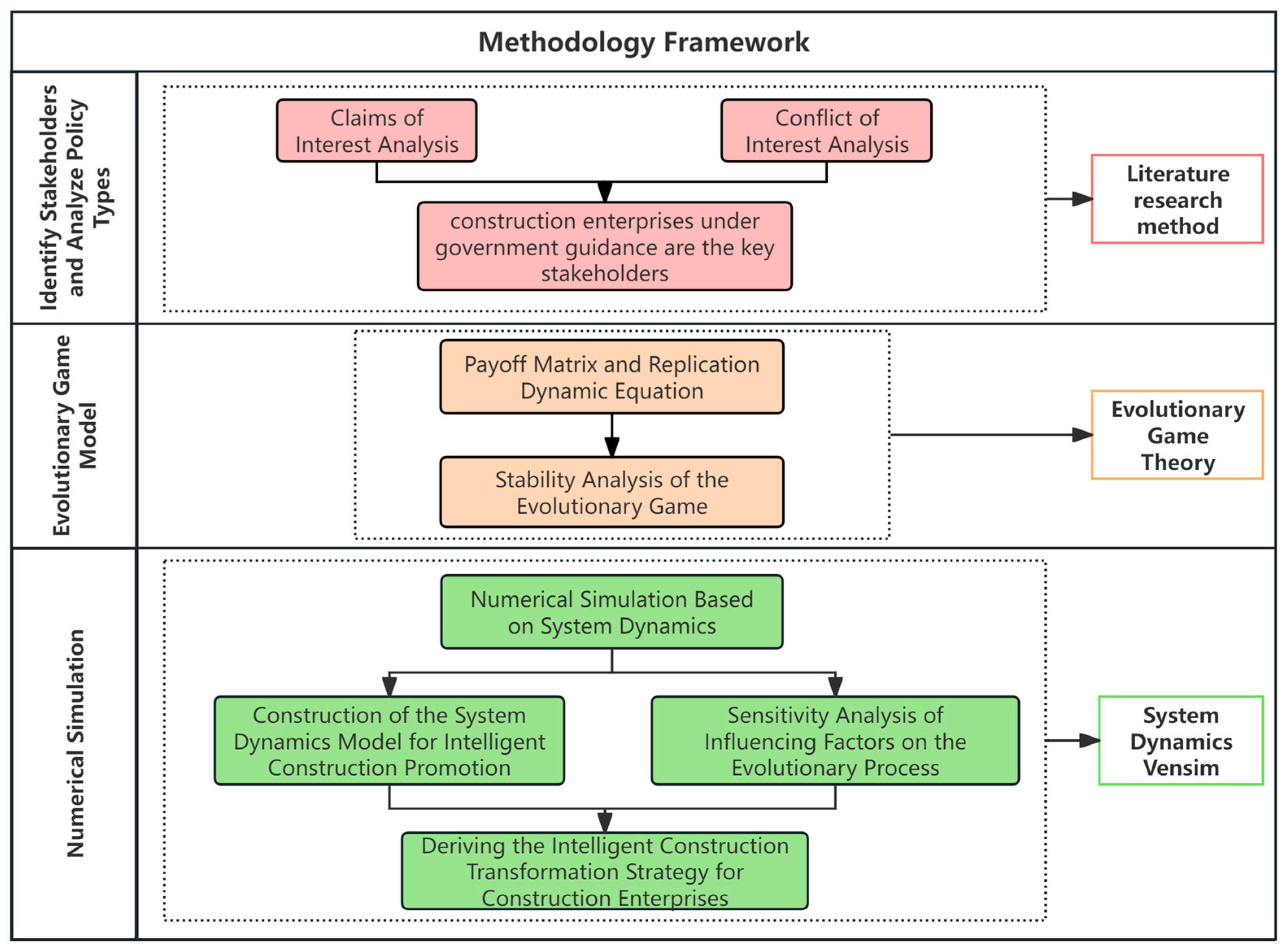

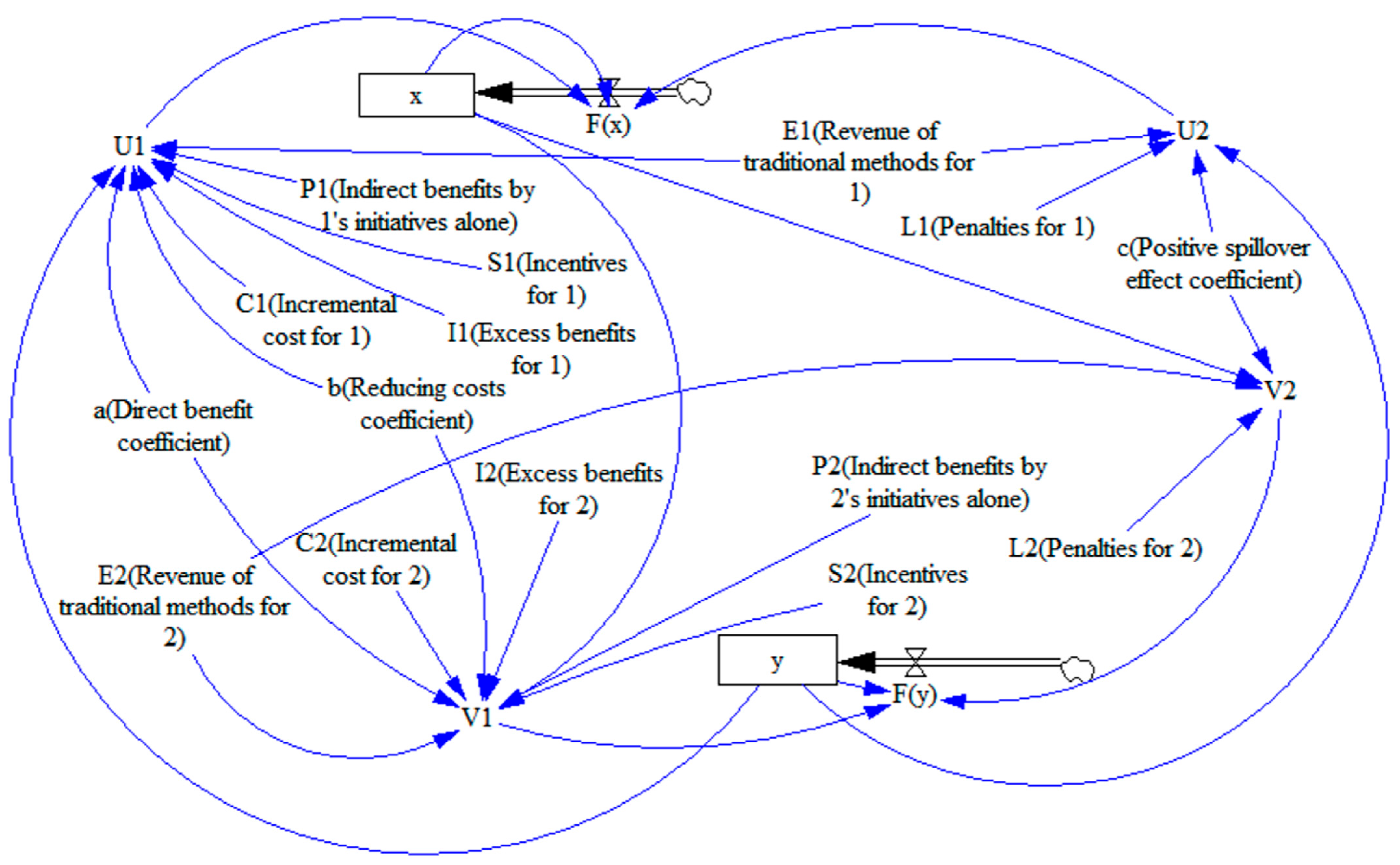
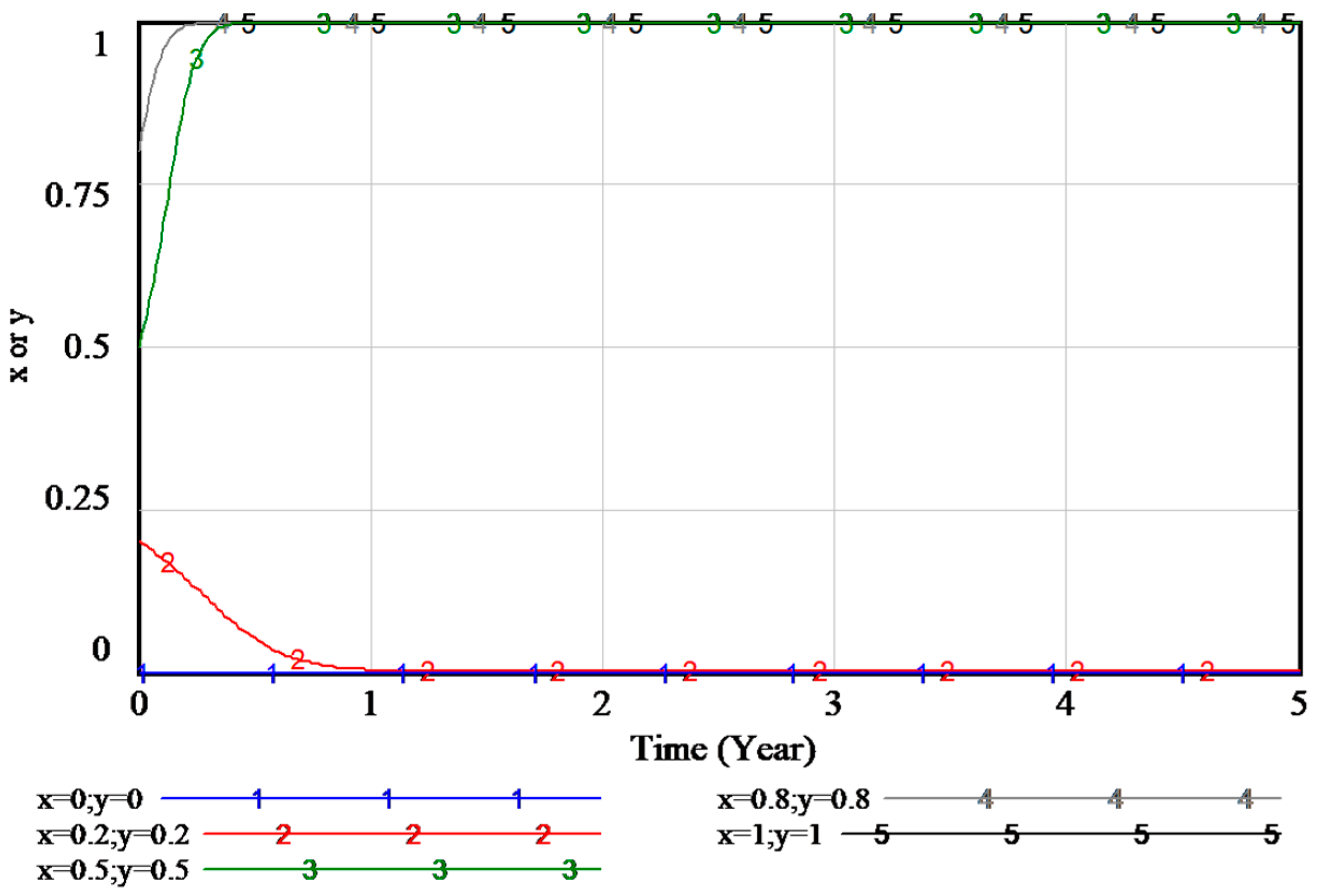

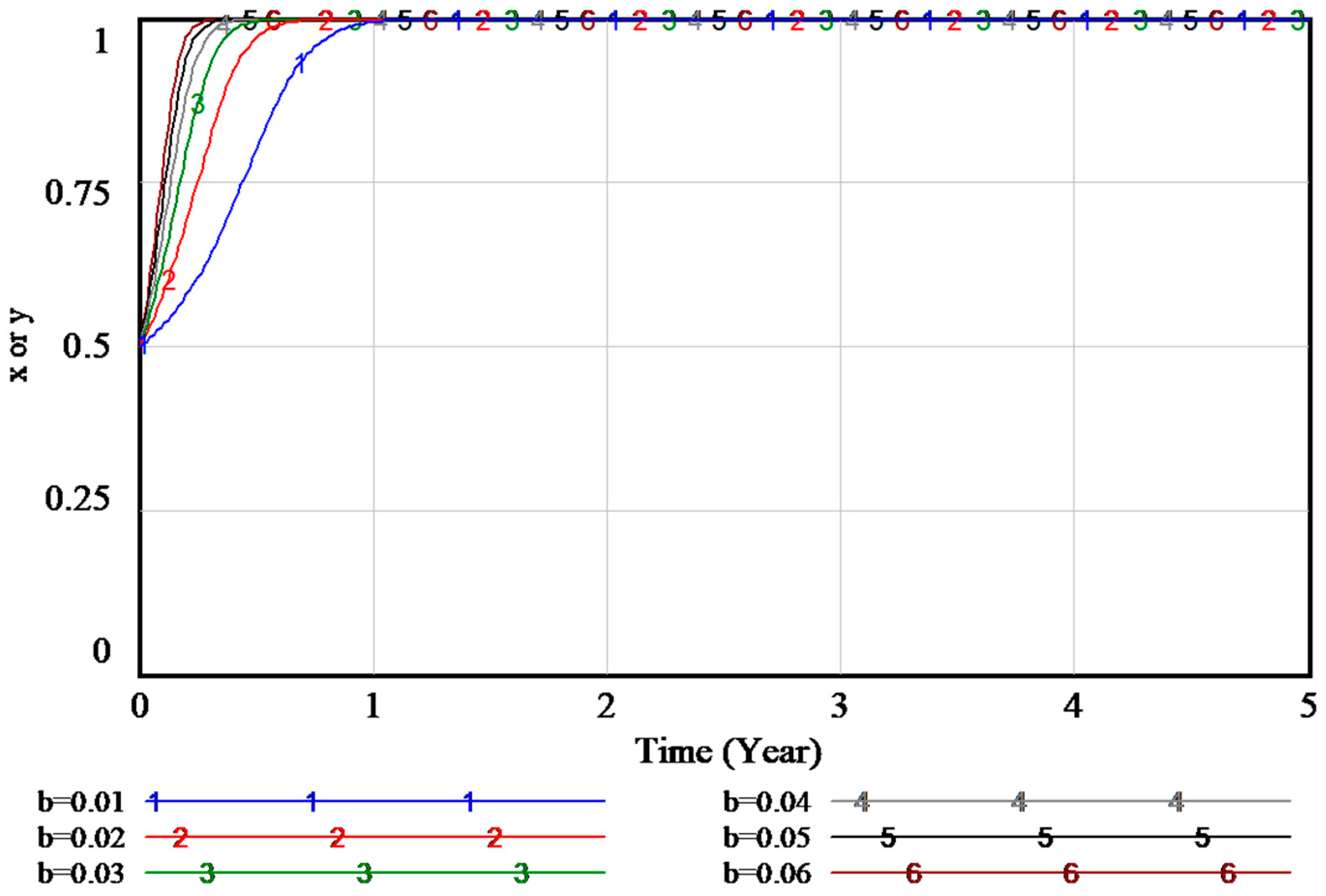




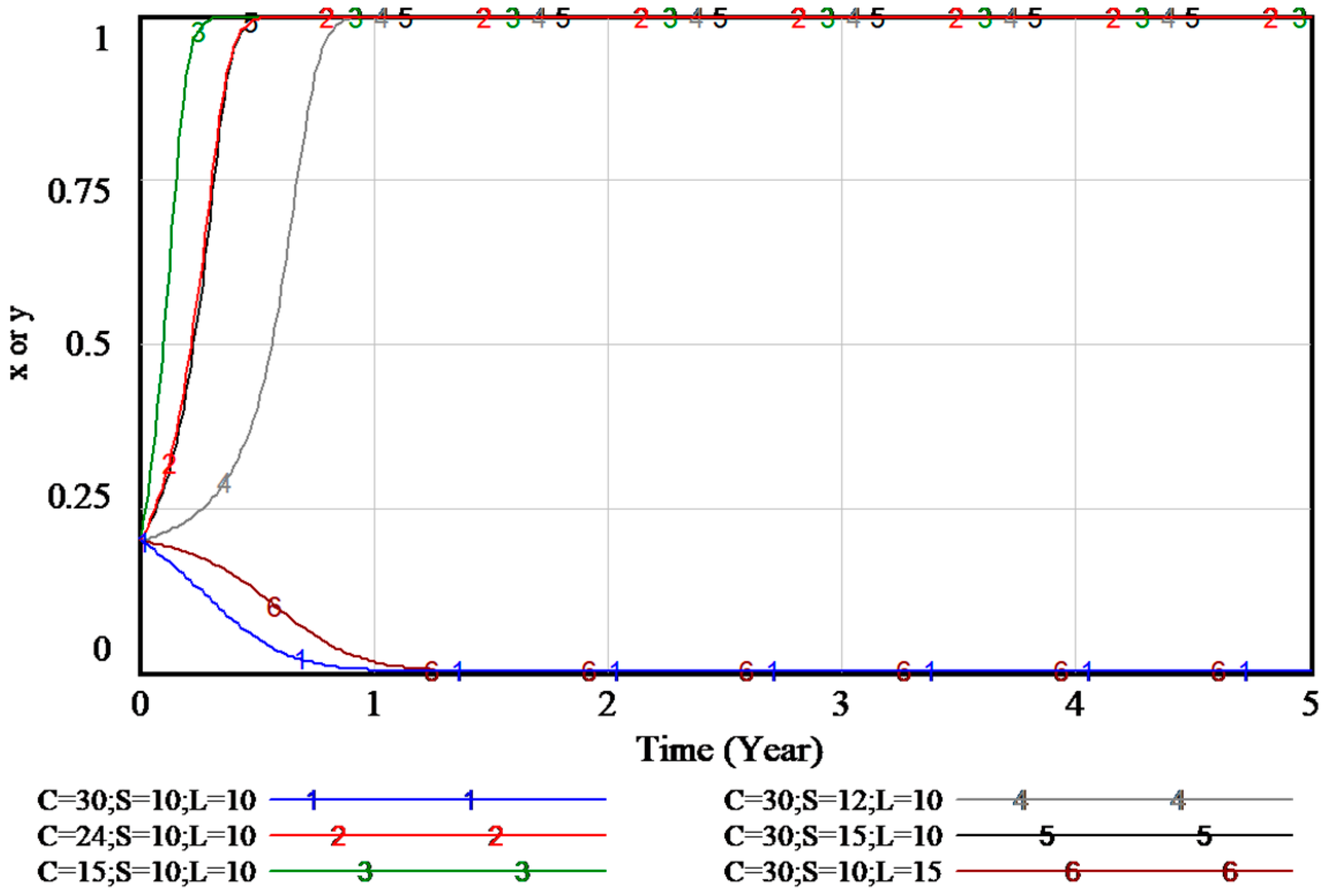


| Parameters | Definition |
|---|---|
| x | Probability of Construction Enterprise 1 adopting intelligent construction |
| y | Probability of Construction Enterprise 2 adopting intelligent construction |
| E1, E2 | The revenue for construction enterprises using traditional methods |
| C1, C2 | Incremental costs for construction enterprises using intelligent construction methods |
| a | The coefficient for direct benefit obtained by construction enterprises using intelligent construction methods |
| b | The coefficient for reducing costs through active cooperation by both parties using intelligent construction methods. |
| I1, I2 | Excess benefits through active cooperation by both parties using intelligent construction methods. |
| P1, P2 | Indirect benefits when only one party uses intelligent construction methods |
| c | The coefficient for the positive spillover effect obtained by one party due to opportunism when only one party uses intelligent construction methods. |
| S1, S2 | Incentives for the implementation of intelligent construction promoted by the government. |
| L1, L2 | Possible penalties for construction enterprises opting traditional construction |
| Construction Enterprise 1 | Construction Enterprise 2 | |
|---|---|---|
| Implement Intelligent Construction (y) | Implement Traditional Construction (1 − y) | |
| Implement intelligent construction (x) | E1 + aE1 + I1 + S1 − (1 − b) C1 | E1 + aE1 + S1 + P1 − C1 |
| E2 + aE2 + I2 + S2 − (1 − b) C2 | E2 − L2 + cE2 | |
| Implement traditional construction (1 − x) | E1 − L1 + cE1 | E1 |
| E2 + aE2 + S2 + P2 − C2 | E2 | |
| Equilibriums | Case 1 | Case 2 | Case 3 | ||||||
|---|---|---|---|---|---|---|---|---|---|
| Det(J) | Tr(J) | Results | Det(J) | Tr(J) | Results | Det(J) | Tr(J) | Results | |
| O (0, 0) | + | − | ESS | + | + | unstable point | − | ± | saddle point |
| A (0, 1) | + | + | unstable point | + | − | ESS | +/− | ± | saddle point |
| B (1, 0) | + | + | unstable point | + | − | ESS | +/− | ± | saddle point |
| C (1, 1) | + | − | ESS | + | + | unstable point | − | ± | saddle point |
| D (x*, y*) | − | 0 | saddle point | 0 | saddle point | − | 0 | saddle point | |
| Influencing Factors | Partial Derivative Results | |
|---|---|---|
| a | <0 | ↓ |
| b | <0 | ↓ |
| c | >0 | ↑ |
| C1, C2 | >0 | ↑ |
| S1, S2 | <0 | ↓ |
| L1, L2 | <0 | ↓ |
| Parameter Name | E1, E2 | C1, C2 | a | b | I1, I2 | P1, P2 | c | S1, S2 | L1, L2 |
|---|---|---|---|---|---|---|---|---|---|
| Initial Value | 180 | 30 | 5% | 40% | 8 | 5 | 1% | 10 | 10 |
| Parameter Name | Value | |||||
|---|---|---|---|---|---|---|
| Control Group | Experimental Group 1-1 | Experimental Group 1-2 | Experimental Group 2-1 | Experimental Group 2-2 | Experimental Group 3-1 | |
| C1, C2 | 30 | 24 | 15 | 30 | 30 | 30 |
| S1, S2 | 10 | 10 | 10 | 12 | 15 | 10 |
| L1, L2 | 10 | 10 | 10 | 10 | 10 | 15 |
| Description | Initial State | Incremental Cost Decrease by 20% | Incremental Cost Decrease by 50% | Government Incentive Increase by 20% | Government Incentive Increase by 50% | Government Fine Increase by 50% |
Disclaimer/Publisher’s Note: The statements, opinions and data contained in all publications are solely those of the individual author(s) and contributor(s) and not of MDPI and/or the editor(s). MDPI and/or the editor(s) disclaim responsibility for any injury to people or property resulting from any ideas, methods, instructions or products referred to in the content. |
© 2025 by the authors. Licensee MDPI, Basel, Switzerland. This article is an open access article distributed under the terms and conditions of the Creative Commons Attribution (CC BY) license (https://creativecommons.org/licenses/by/4.0/).
Share and Cite
Chen, Y.; Shi, Y.; Ding, M. Dynamic Simulation of Enterprise-Level Strategic Choices in Intelligent Construction: Integration of Evolutionary Game Theory and System Dynamics. Buildings 2025, 15, 3719. https://doi.org/10.3390/buildings15203719
Chen Y, Shi Y, Ding M. Dynamic Simulation of Enterprise-Level Strategic Choices in Intelligent Construction: Integration of Evolutionary Game Theory and System Dynamics. Buildings. 2025; 15(20):3719. https://doi.org/10.3390/buildings15203719
Chicago/Turabian StyleChen, Yingling, Youzhi Shi, and Meichen Ding. 2025. "Dynamic Simulation of Enterprise-Level Strategic Choices in Intelligent Construction: Integration of Evolutionary Game Theory and System Dynamics" Buildings 15, no. 20: 3719. https://doi.org/10.3390/buildings15203719
APA StyleChen, Y., Shi, Y., & Ding, M. (2025). Dynamic Simulation of Enterprise-Level Strategic Choices in Intelligent Construction: Integration of Evolutionary Game Theory and System Dynamics. Buildings, 15(20), 3719. https://doi.org/10.3390/buildings15203719







